
A muzzle brake or recoil compensator is a device connected to, or a feature integral to the construction of, the muzzle or barrel of a firearm or cannon that is intended to redirect a portion of propellant gases to counter recoil and unwanted muzzle rise. Barrels with an integral muzzle brake are often said to be ported.
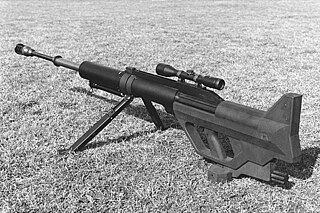
The Steyr IWS 2000 is an Austrian single-shot bolt-action anti-materiel rifle produced by Steyr Mannlicher. IWS stands for Infantry Weapon System. Unlike other anti-tank rifle designs, it has a smoothbore barrel. This facilitates higher projectile velocities and allows a longer barrel service life, but the lack of gyroscopic spin-stabilization requires the projectile to have aerodynamic stabilizing fins instead. The IWS is chambered in a 15.2×169 mm armor-piercing fin-stabilized discarding-sabot cartridge, and is the first man-portable rifle to use this type of ammunition.

The T95 was an American prototype medium tank developed from 1955 to 1959. These tanks used many advanced or unusual features, such as siliceous-cored armor, new transmissions, and OPTAR fire-control systems. The OPTAR incorporated an electro-optical rangefinder and was mounted on the right side of the turret, and was used in conjunction with the APFSDS-firing 90 mm T208 smoothbore gun, which had a rigid mount without a recoil system. In addition, although the tanks were designed with a torsion beam suspension, a hydropneumatic suspension was fitted, and one of the tanks was fitted with a Solar Saturn gas turbine for demonstration purposes.
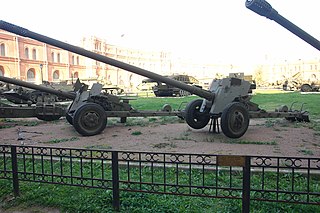
2A19 or T-12 is a Soviet-designed 100-mm anti-tank gun. It was the first anti-tank gun to adopt a smoothbore barrel, and to introduce modern armor piercing shot, like the APFSDS. It uses long projectiles that are more powerful than its caliber suggests. The T-12 served as the primary towed anti-tank artillery in the Soviet and Bulgarian armies from the early 1960s to the late 1980s.
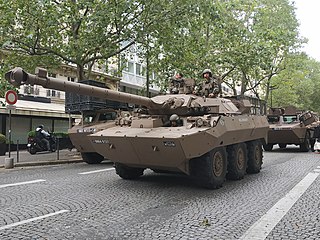
The AMX-10 RC is a French armoured fighting vehicle manufactured by Nexter Systems for armoured reconnaissance purposes. Equipping French cavalry units since 1981, over 240 remained in service with the French Army in 2021. 108 units were sold to Morocco and 12 to Qatar. "RC" stands for "Roues-Canon", meaning "wheeled gun". English language newspapers have often incorrectly referred to it as a light tank, a mistranslation of the French term "char", which refers to a wider category of armored fighting vehicles than the English word "tank".
The following is a list of ammunition fired by the 125 mm smoothbore gun series used in the T-64, T-72, T-80, M-84, T-90, PT-91, T-14 Armata, and other tanks derived from those designs, as well as the 2A45 Sprut anti-tank gun.
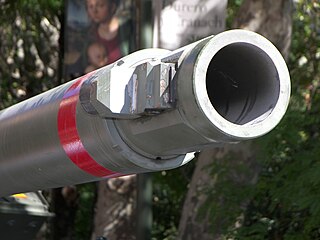
The Rheinmetall Rh-120 is a 120 mm smoothbore tank gun designed and produced in former West Germany by the Rheinmetall-DeTec AG company, it was developed in response to Soviet advances in armour technology and development of new armoured threats. Production began in 1974, with the first version of the gun, known as the L/44 as it was 44 calibres long, used on the German Leopard 2 tank and soon produced under license for the American M1A1 Abrams and other tanks. The 120-millimetre (4.7 in) gun has a length of 5.28 metres (17.3 ft), and the gun system weighs approximately 3,317 kilograms (7,313 lb).

The M829 is an American armor-piercing fin-stabilized discarding sabot (APFSDS) tank round. Modeling was done at the Ballistic Research Laboratory at Aberdeen Proving Ground, which was incorporated into the Army Research Laboratory in 1992. The round is specifically designed for the 120 mm M256 main gun on the Abrams M1A1 and M1A2 main battle tanks. The penetrator is carried by a sabot during its acceleration in the gun barrel.
National Defence Complex (NDC), (Urdu: مستقرِ قومی دفاع) also known as National Development Complex, National Development Centre, is a Pakistani state-owned defence and aerospace contractor which is a division under the National Engineering and Scientific Commission (NESCOM). It is based in Fateh Jang, Rawalpindi, Pakistan.

The 76 mm gun M1 was an American World War II–era tank gun developed by the U.S United States Ordnance Department in 1942 to supplement the 75 mm gun on the basic Medium tank M4. It was also used to arm the M18 Hellcat tank destroyer.

2.8 cm schwere Panzerbüchse 41 or "Panzerbüchse 41" was a German anti-tank weapon working on the squeeze bore principle. Officially classified as a heavy anti-tank rifle, it would be better described, and is widely referred to, as a light anti-tank gun.

The 7.5 cm KwK 40 was a German 75 mm Second World War era vehicle-mounted gun, used as the primary armament of the German Panzer IV medium tank and the Sturmgeschütz III and Sturmgeschütz IV assault guns which were used as tank destroyers.

The Ordnance QF 32 pounder or (32-pdr) was a British 94 mm gun, initially developed as a replacement for the Ordnance QF 17-pdr anti-tank gun.

The Royal Ordnance L11A5, officially designated Gun 120 mm Tk L11, is a 120 mm L/55 rifled tank gun design. It was the first of NATO's 120 mm main battle tank guns which became the standard calibre for Western tanks in the later period of the Cold War. A total of 3,012 of the L11 guns were produced by 2005. The list price was US$227,000 in 1990.

The Canon de 105 mm modèle F1 is a French 105 mm tank gun used with the AMX-30.
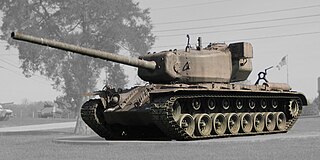
The 105mm L/65 T5 was an American rifled anti-tank gun developed in 1945. The T5E1 was the main armament for several American WWII heavy tanks designs, including the double-tracked T28 Super Heavy Tank and T29 Heavy Tank.
The Tampella 100 PSTK is a Finnish towed 100 mm anti-tank gun, designed in the 1980s by Tampella. It was designed for commonality with the D-10T tank gun, in use by the Finnish Defence Forces in the T-54 and T-55 tanks, as well as the 100 56 TK coastal artillery piece. However, due to multitude of reasons it never went into serial production.

The 75 SA 49 is a French 75 mm low-recoil rifled gun specially designed to be mounted on the EBR eight-wheeled armored reconnaissance vehicle.
The 75 SA 50 also called 75 Mle 50 or CN 75-50 is a French 75 mm high-velocity rifled gun. Although originally designed for the AMX-13 light tank, the SA 50 has also been used on the EBR wheeled reconnaissance vehicle and foreign medium tanks such as the Israeli upgraded Super Sherman.
The 60mm HVMS gun is a self-loading autocannon jointly developed by OTO Melara of Italy and the Israel Military Industries (IMI). It was designed to be mounted on light armoured vehicles to provide an anti-armour capability using high-velocity sub-calibre kinetic ammunition.















